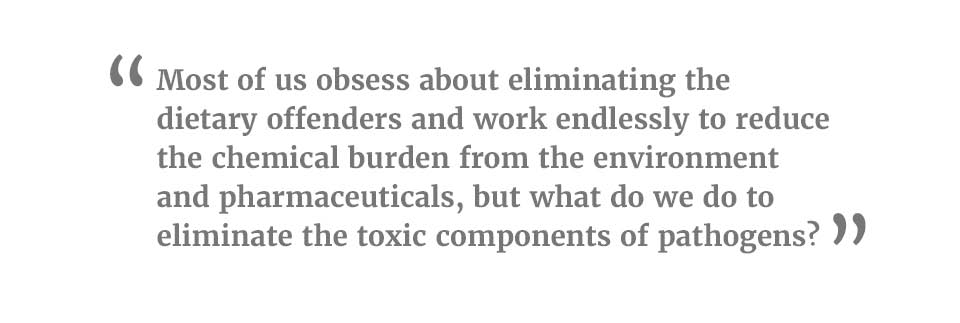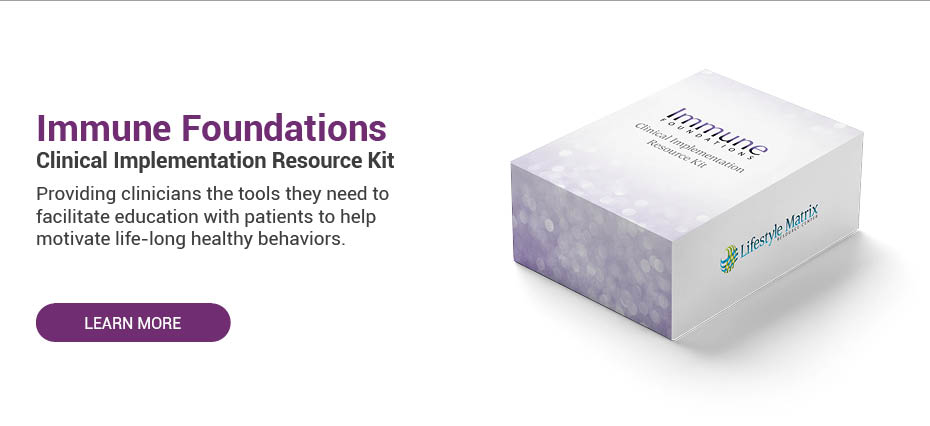It’s no secret that so many Americans suffer from chronic disease, especially autoimmunity. We have done a great job making the connection to leaky gut; however, sometimes healing leaky gut can be a conundrum, and new evidence supports the idea
of endotoxins playing a role in patients that seem to stall in their treatment. Maybe you’re reading this and saying, “I’ve got a great leaky gut protocol! Glutamine, probiotics, elimination diet. It works great, but sometimes I
feel like I’m missing something.” Let’s talk about what endotoxins are, how they perpetuate inflammation, and therapeutic interventions that could address this overlooked piece of the puzzle.
Since the gut epithelium is the most common point of entry from the outside world to the inside of our body, we focus a lot on gut health and restoring barrier function. However, have you ever tried to heal a tissue without removal of assault? It’s impossible. Healing a disc injury when the patient won’t stop repeating the offending movement, healing a scab when a child won’t stop picking it, healing the gut without removing offenders—these are examples of how difficult it is for complete healing to occur in a reasonable amount of time without addressing the cause. In the gut, there are three major assailants doing damage: gliadin (a protein found in wheat), chemicals, and pathogens and their toxins. Most of us obsess about eliminating the dietary offenders and work endlessly to reduce the chemical burden from the environment and pharmaceuticals, but what do we do to eliminate the toxic components of pathogens? After all, we are treating many patients for infections without regard to what happens when the pathogens disassemble and release their components and contents! Let’s talk about this third gut assailant: endotoxins.

What is an Endotoxin?
An endotoxin is a complex lipopolysaccharide found in the outer membrane of gram negative bacteria. The list of gram negative bacteria is extensive, but common examples are E. coli, Klebsiella pneumonia, H. pylori, and Enterobacteriaceae. In humans, the presence of LPS triggers an innate immune response, activating the immune system and producing inflammatory cytokines. If you start searching the literature for LPS involvement in virtually any immune disease, you may be surprised at how much we already know about the connection between LPS and chronic immune disorders.
How Do Endotoxins (LPS) Drive Chronic Inflammation?
In the presence of leaky gut, LPS has a direct mode of entry to immune cells waiting on the other side of the gut epithelium. Due to that open access, abnormal exposure to LPS can chronically engage those immune cells. When they encounter such intruders, one of the important jobs of the immune cells is to initiate an inflammatory cascade and create a long-term memory for subsequent exposures. Once the mucosal immune system of the gut is triggered to respond to a potential threat, the inflammatory process engages and may persist well after the original trigger is neutralized. Prolonged or inappropriate inflammatory responses by the immune system can, in turn, lead to signals that promote further intestinal permeability, leading to chronic cycles of inflammation. Therefore, it is imperative to consider all intestinal barrier issues as having an immune/inflammatory component, meaning therapies designed to improve intestinal barrier function should also include immune-supporting and anti-inflammatory components.
Immunoglobulin Supplementation for Addressing Endotoxins
The question then becomes, while addressing the increase in permeability, is there a way to limit the exposure to the antigens that upregulate inflammation and result in tissue damage? Many binding studies have demonstrated serum-derived bovine IgG has binding capabilities to many of the PAMPs associated with human pathogens, including C. difficile, Toxin A and B, E. coli, H. pylori, and LPS. Binding and removal of antigens enables normal healing processes in the gut epithelium to occur and prevents excessive release of inflammatory cytokines. The use of oral IgG with broad-spectrum binding capabilities should be considered in a comprehensive GI protocol due to the passive immunity provided at the barrier. This prevents endotoxins from presenting to the immune system.
Removing burden from the immune system while simultaneously addressing dysbiosis is the first step in allowing enterocyte healing to occur. Enterocyte healing is more efficient when tissue inflammation is not present. There are additional options that support both immune and GI barrier function, such as glutamine, probiotics, anti-inflammatory and immunomodulatory herb or botanical extracts (e.g., curcumin, boswellia, Scutellaria baicalensis, propolis, etc.), omega-3 fatty acids, and vitamin D, but only oral immunoglobulins can bind and remove some of the most potent immune activators.
When treating patients with autoimmune disease, removing gut offenders like gliadin, chemicals and endotoxins will increase treatment efficacy and reduce the time it takes for these patients to make significant progress. Oral IgG has made it’s mark as a viable treatment consideration for these patients, and can join the ranks of glutamine and probiotics as important components of a treatment protocol for intestinal permeability.
ANGELA LUCTERHAND, DC

Dr. Angela Lucterhand received her doctorate in chiropractic from Palmer College of Chiropractic in Davenport, Iowa. While there, she was a graduate
teaching assistant for courses including Anatomy and Physiology, Histology, the Central Nervous System, and Spinal Anatomy. She received her Bachelor of Arts at Indiana University.
Her interest in basic health care led her to become a Health Education Specialist with the Peace Corps, where she served in Mali, West Africa. Dr. Lucterhand loves teaching and was an adjunct professor for Anatomy and Physiology at Ivy Tech. Her passion in practice is addressing the root causes of disease and emphasizing the impact of lifestyle medicine.
Dr. Lucterhand practices chiropractic and functional medicine in Elkhart, Indiana, and currently holds the position of Immune Foundations Brand Manager at the Lifestyle Matrix Resource Center.






